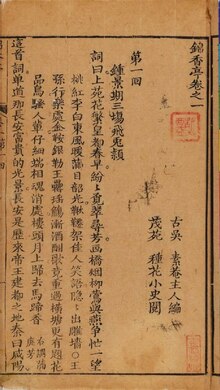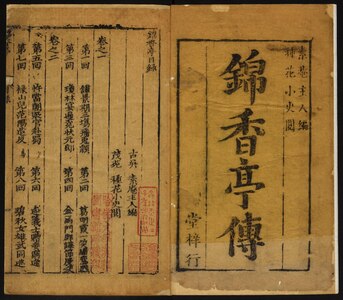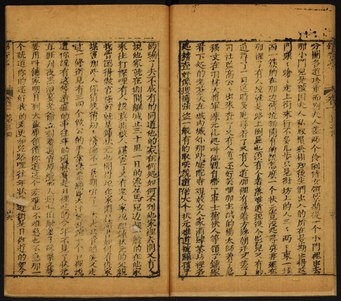
Jinxiang ting (traditional Chinese: 錦香亭; simplified Chinese: 锦香亭)[1] or Jinxiang ting zhuan (traditional Chinese: 錦香亭傳; simplified Chinese: 锦香亭传), translated into English as Jinxiang Pavilion,[2] the Pavilion of Brocade and Aroma[3] and several other translated titles,[a] is a Chinese romantic novel of the caizi jiaren genre from the late 17th-century to the early 18th-century.[4] Its authorship is ascribed to a writer named Su An Zhu Ren (素庵主人) or Gu Wu Su An Zhu Ren (古吳素庵主人), which is a pseudonym.
-
Title page of the novel
-
Pages from chapter three of the novel
Notes
[edit]- ^ Other English translated titles of the novel include Pavilion of Embroidered Fragrance and a few others.
Citations
[edit]- ^ McMahon, Keith (1995). Misers, Shrews, and Polygamists: Sexuality and Male-female Relations in Eighteenth-century Chinese Fiction. Duke University Press. p. 310.
- ^ Sieber, Patricia; Llamas, Regina (2022). How to Read Chinese Drama: A Guided Anthology. Columbia University Press. p. 59.
- ^ Salmon, Claudine, ed. (2013). Literary Migrations: Traditional Chinese Fiction in Asia (17th-20th Centuries). Institute of Southeast Asian Studies. p. 144. ISBN 9789814414326.
- ^ Chinese Literature, Essays, Articles, Reviews. Vol. 25. Coda Press. 2003. p. 63.
many works of the scholar - beauty fiction such as Haoqiu zhuan and Jinxiang ting from the early Qing period.


Well, that’s interesting to know that Psilotum nudum are known as whisk ferns. Psilotum nudum is the commoner species of the two. While the P. flaccidum is a rare species and is found in the tropical islands. Both the species are usually epiphytic in habit and grow upon tree ferns. These species may also be terrestrial and grow in humus or in the crevices of the rocks.
View the detailed Guide of Psilotum nudum: Detailed Study Of Psilotum Nudum (Whisk Fern), Classification, Anatomy, Reproduction